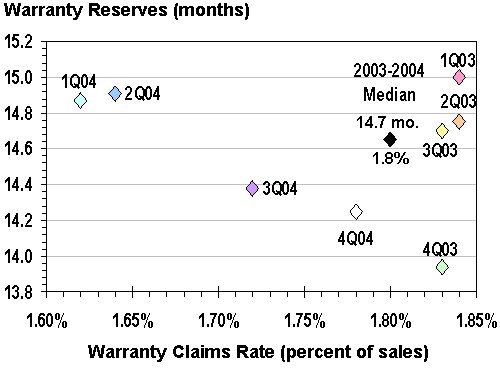May 17, 2005 |

|
ISSN 1550-9214 |
Warranty Reserves:How much is enough? Given a company's industry and the nature of its product warranties, how much should be kept in the warranty reserve fund? The funding decisions of 700 CFOs provide some insights.American manufacturers ended 2004 with $37.25 billion in their warranty reserves, which at current claims rates would be enough to fund payments for the next 17 months. Is that enough? Or is it too much or too little? Nobody knows better than a given company's chief financial officer whether a given amount is adequate. The CFO knows in detail the warranty claims history of each and every product line. The CFO knows how many products are in the field and how many are still under warranty, and the CFO can use past history to make very educated guesses concerning how many claims to expect in the future. The best an outsider can do is to look at the public information of all manufacturers, which is averaged across all their product lines. All we get in their financial statements are net figures for the beginning and ending balance of the reserve fund, claims paid, accruals made, and any adjustments made because of foreign currency swings, acquisitions, or divestitures. Many times, those figures are rounded off to the nearest million. So while the CFO of an automaker can probably predict the claims experience just for blue trucks in Montana with four-wheel drive, all an outsider can determine is the claims experience of all vehicles in all locations. So it is impossible for an outsider to say with certainty that a given amount of warranty reserves is adequate. And of course, one cannot say whether a prediction was correct until it's in the past tense. Therefore, we need a different approach. We need the CFOs themselves to tell us how much they think is adequate. We don't need all the details of their methodologies. All we need is to see where they stand in respect to all the other CFOs in their industry. Measuring Warranty CapacityFirst we need to invent a new measure of capacity for the warranty reserve, because balances range from the thousands to the billions of dollars. So let's say a somewhat large manufacturer is reporting claims payments of $3 million per quarter, or $1 million per month. Let's say their warranty reserve fund balance at the end of a given quarter is $15 million. One could therefore say that the reserve fund has a capacity of 15 months -- meaning that it could pay for the next 15 months' worth of claims even if no further accruals were made. By the same measure, a small company paying out $2000 a month with $30,000 in the bank would be able to fund claims for 15 months. Then without any further accruals, the funds would be exhausted. Of course, no company would cease making accruals, so that would never happen. And we're sure that no CFO would ever manipulate accruals or reserve fund balances in a way that artificially inflated or dampened earnings. Call us naïve, but we're going to take it as a given that the warranty reserve fund balance at any moment in time reflects exactly what the CFO believes is the precise amount needed to pay all future claims on products sold up to the present day. That should be the case whether there is a thousand or a billion dollars in the reserve fund. If U.S.-based manufacturers had $37.25 billion in reserve as of Dec. 31 and if they paid $6.6 billion in claims during the fourth quarter of 2004, then at a rate of $2.2 billion per month those reserves would last them around 17 months. To be precise, the funds would last exactly 16.8 months at the rates seen at year's end. Diving deeper, the capacity to pay claims would vary by company, by industry, by the average length of warranties, and by numerous other factors. For General Motors, their $9.1 billion in reserves would last them 22 months. That may be typical for an automotive OEM. Nortel Networks' $275 million would last them a little over 7 months. That may be typical for a telecom equipment manufacturer. Or maybe not. Eight Quarters of DataThe first thing we did was to count up where all manufacturers stand. With eight quarters of warranty data in hand, and with useable data for between 651 and 718 companies during each of those quarters, we had available a total of 5,530 pairs of measurements of reserve fund balances and claims paid per month. It would be one thing to dump them all into a bucket and take a mathematical average, as was done above. It would be something else entirely to divide them into groups based upon where they stand in relation to each other. If we take just an average, the results are going to be heavily weighted by companies such as GM, Ford Motor, Hewlett-Packard, Dell, General Electric, and United Technologies, which each keep a billion or more dollars in their reserve funds, and which each pay out more than a million dollars a day in claims. That's going to reflect the perspectives of six CFOs, not 700 or more. It would be better to find a way of ranking all 700-something CFOs. Here's the theory: put 700 CFOs in a room, and ask them how much they really need in warranty reserves to fund future claims and protect their companies from sudden spikes. Whatever their answer, find the midpoint at which 350 are above and 350 are below that level. That would be the median -- the dividing line between the optimists and the pessimists. Half the CFOs believe they need more than the median to pay future claims, and half believe they can get away with less than the median. During the first quarter of 2004, 713 manufacturers included in their financial statements all the needed details on their reserve fund balance and the net amount of claims paid. Reserve fund capacity ranged from one month to 858 months, and the one in the middle was 14.9 months. In the quarters before and since, the median has remained within a range of 13.9 to 15.0 months. Taking all 5,530 measurements at once, the median was 14.7 months. Payments vs. Capacity to PayLet's add one more measurement to each of these figures and turn it into a graph. We can't measure installed base or the average length of warranties on products in the field. But we can measure claims rate, as a percentage of product revenue. Over the past eight quarters, the claims rate for all manufacturers has ranged from 1.62% to 1.84%. What follows is a graph where the vertical axis measures reserve fund capacity in months, and the horizontal axis measures claims rate in percent of product sales. Warranty Reserves & Claims Rates | |||||||||||||||||||||||||||||||||||||||||||||||||||||||||||||||||||||||||||||||||||||||
| Back to Part Two |

|
This Week’s Warranty Week Headlines | ||
|
Amusement park manager, who stopped repairing ride after warranty ran out, is convicted of reckless homicide. Associated Press, May 17, 2005 | ||
|
ATX Group president sees vehicle telematics and wireless networks as warranty cost-reducing technologies. Press Release, May 17, 2005 | ||
|
ProQuest Business Solutions signs Kawasaki Motors, Stihl, and others to use its parts catalog and warranty solutions. Press Release, May 17, 2005 | ||
|
ARI Network Services Inc. signs Kioti Tractor as first customer to use ARI WarrantySmart product registration and warranty claim processing software. Press Release, May 17, 2005 | ||
|
Hernandez Companies Inc. to provide service and maintenance to holders of Home Services of America home warranty contracts. Press Release, May 17, 2005 | ||
More Warranty Headlines below | ||

|
Warranty Headlines (cont’d) | ||
|
Chrysler to end seven-year powertrain warranty with 2006 models; reverting back to three years/36,000 miles. Reuters, May 16, 2005 | ||
|
Delphi meets about refinancing as two more executives resign because of the accounting investigation. Associated Press, May 16, 2005 | ||
|
Cimtek to partner with the Peer Group Inc. to provide centralized management and remote monitoring capabilities to companies with distributed manufacturing processes. Press Release, May 16, 2005 | ||
|
McCusker & Associates LLC to use telecom solutions from PowerNet Global for its Beyond Warranty call center operations. Press Release, May 16, 2005 | ||
|
Columnists advises readers to buy extended warranties directly from PC manufacturer, but to watch for exclusions. Fort Myers (FL) News-Press, May 16, 2005 | ||
More Warranty Headlines below | ||

|
Warranty Headlines (cont’d) | ||
|
Plastic surgeon says his Breast Implant Registry will notify patients when their ten-year warranties expire. Press Release, May 14, 2005 | ||
|
Nationwide Autocentres says it will repair MG Rover vehicles covered by now-worthless warranties at half price. Car Keys UK, May 13, 2005 | ||
|
Magazine publishes guide to automotive lemon laws by state. Woman Motorist, May 12, 2005 | ||
|
Tellabs FiberDirect Solution Purchase Program offers longer warranties to telcos installing fiber-to-the-home networks. Press Release, May 12, 2005 | ||
|
GM recalling 300,000 trucks and SUVs because of turn signal problem identified through warranty reports. Associated Press, May 10, 2005 | ||
More Warranty Headlines below | ||

|
Warranty Headlines (cont’d) | ||
|
ServiceMaster's company-wide net income down slightly in first quarter but operating income at its American Home Shield unit soars. Press Release, May 10, 2005 | ||
|
Warranty Direct Ltd. suggests people who bought an MG Rover car with their Visa Debit Card should complain to the UK's Financial Ombudsman Service that the bank won't honor their warranty. carpages.co.uk, May 10, 2005 | ||
|
GE Auto Warranty Services trains more than 200 agents, expands number of active auto dealerships by 36% during a 12-month period. Press Release, May 10, 2005 | ||
|
NJ Governor orders state Department of Community Affairs to develop a Web site where consumers can view complaints against builders. Newark Star-Ledger, May 10, 2005 | ||
|
Microsoft's Maestro project aims to deliver business-intelligence software that can provide warranty reports and can work with SAP, Oracle and Siebel. CNET News.com, May 9, 2005 | ||
More Warranty Headlines below | ||
|
|
Warranty Headlines (cont’d) | ||
|
ServiceBench enhances online communications options for field servicers and automated mailings of surveys for marketing and warranty fraud detection. Press Release, May 9, 2005 | ||
|
Two-week puppy warranty doesn't cover the pneumonia that snuffed out Snuggles, says sellers at local Pet City store. WSLS-TV Roanoke VA, May 9, 2005 | ||
|
June 2005 issue of Consumer Reports finds less than 1% of mattresses are returned for warranty failures such as broken springs. Press Release, May 9, 2005 | ||
|
Solar energy company PV Powered CEO explains why he gives 10-year warranties on his inverters while others give only five years. Press Release, May 9, 2005 | ||
|
ARI Network Services Inc. wins the "IQ (Innovation Quotient) Award" from Small Business Times magazine and the Wisconsin Technology Council. Press Release, May 9, 2005 | ||
More Warranty Headlines below | ||

|
Related Articles From Warranty Week |




